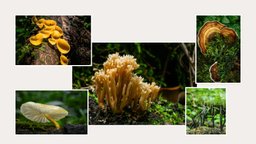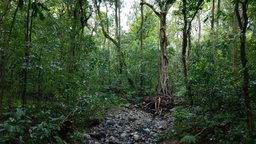THE HIDDEN CONVERSATIONS BETWEEN TREES
Spend a little time in the forest and you’ll quickly discover that it is far from silent. The rustling leaves, the rhythmic chorus of birds and insects, and the occasional bushbuck or monkey alarm call, are all audible to the human ear. Yet beneath the soil, where our ears cannot follow, another form of communication hums away. It is here, hidden in the dark, that trees speak most profoundly to one another.
For centuries people believed forests were battlegrounds of silent competition. Each tree locked in a fight for sunlight, water and space. But research over the past three decades has challenged that view. Pioneering ecologists like Suzanne Simard have uncovered that forests are not just collections of individuals. They are communities bound together by complex underground networks that rival our own cities in sophistication.
At the heart of this discovery lies the mycorrhizal network. Vast webs of fungi weave through soil and connect to the roots of trees. These fungi trade minerals and water for sugars produced by the trees, forming a mutually beneficial partnership. But the relationship extends far beyond simple exchange. Using these fungal threads, trees can send chemical signals and even share resources.
Imagine an acacia tree sensing drought. Instead of hoarding every drop of moisture for itself, it can channel extra water or nutrients to nearby saplings through the fungal web. Studies have shown that larger, older trees, sometimes called mother trees, often support younger seedlings in this way, giving them a better chance of survival. When pests strike, trees can also release chemical distress signals through their roots, warning neighbours to bolster their defences. What once seemed like silent stoicism is now understood as urgent conversation.
These insights into the “Wood Wide Web” began with simple experiments. Scientists traced carbon isotopes placed into one tree and later found those same isotopes appearing in others. This proved resources were moving between individuals underground. Since then, researchers have mapped how signals travel, how trees distinguish kin from strangers, and how even different species of trees can collaborate. It is cooperation on a scale humans rarely imagined in the natural world.
But this field is still unfolding. Some scientists argue we should be cautious in how we describe tree communication, warning against drawing too close a parallel with human language or intention. After all, we do not yet fully know whether these exchanges represent conscious choices or simply evolved strategies for survival. Yet what is clear is that forests are dynamic societies. Interconnected, responsive and more cooperative than competitive.
Understanding this hidden network changes how we view conservation. To cut down one tree is not just to lose an individual. It is to silence a voice in a greater community. The echoes of its absence ripple through the underground web, affecting countless neighbours. Protecting forests then is about preserving relationships, not just species.
Walk through Arusha National Park and you can feel this connectedness. The towering fig trees, whose aerial roots dangle like cathedral pillars, are part of this underground society. Not only that, but several other organisms hint at this underground network and silent chorus. Mushrooms sprout out of rotting wooden bark and dewy moss carpets the floor, all alluding to the fact and emerging science of a network we cannot tap into.
This is the magic guests at Koroi Forest Camp are invited to experience. Nestled among the trees, the camp is more than a place to rest. It is an invitation to listen differently. To walk softly on the soil that carries messages from one root to another. To breathe in the air laced with signals and scents. To recognise that the forest is never silent. It is talking patiently, constantly, profoundly.
Perhaps the lesson is this. In a world so often defined by competition, the trees remind us that survival is deeply social. Beneath the forest floor, cooperation is not an exception. It is the rule. And if we learn to listen, the forest speaks volumes.










